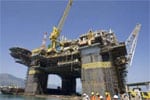 |
|
Brazilian oil giant Petrobras will use debt issuance to finance new offshore exploration. |
The Petrobras state-controlled oil company sold $1.5 billion of 10-year bonds on international markets in February. The deal, which carries a 7.875% coupon, was managed by HSBC, JPMorgan Chase and Santander and was issued through the company’s Petrobras International Finance division. Proceeds will be used to help finance a $174.4 billion five-year investment program through 2013, which is 55% higher than the previous five-year plan. The plan, delayed since last September amid a sharp drop in oil prices, was unveiled in January and includes $28.6 billion in investments this year alone. Part of the investment plan focuses on developing new offshore pre-salt oil finds, ranked as the largest oil find in the hemisphere in three decades. Petrobras aims to boost crude output from a current 2.2 million barrels per day (bpd) to 3.3 million bpd in 2013 and 5.7 million bpd by 2020. Part of the five-year investment plan will be funded through an $11.9 billion loan this year from the BNDES state-owned development bank. BNDES will lend the company another $10 billion next year.
Responding to an uproar from business groups, the Brazilian government suspended a controversial rule requiring prior licensing for 70% of imported goods. The Decex foreign trade agency planned to reimpose import controls after imports had undergone an automatic approval process online for statistical purposes. Exporters within the Mercosur trade bloc objected to the move, as did local importers and producers. Analysts say the measure, which was lifted just four days after its introduction, had been prompted by January’s $645 million trade gap. This was the first trade deficit since March 2001.
Antonio Guerrero



